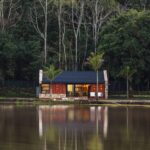Sep 10, 2013 • Apartment
Introducing Standalone Structures to Create Space

This stunningly stylish apartment from South Kensington, London, was carefully renovated by Hogarth Architects. The apartment is part of a listed building, which prevented the architects from modifying certain elements of the build (like the fireplace and cornices). However, it didn’t stop them from creating an amazing space that won them The Daily Telegraph British Homes Award.

As part of the revamp they first had to restore the “space to its original proportions; open plan and voluminous“. To do this they removed 3 existing rooms that divided up the apartment and a false ceiling. Once this stage of the project was complete they were able to move on the the next phase – introducing a new layout.

The new layout comes in the form of a large timber structure that defines separate living areas without closing them off from one another. The new addition houses the bathroom, bedroom, kitchen and a mezzanine that overlooks the living area. The rustic, chunky wood is complimented by accents of frosted glass, used to conceal and define, private and semi-private living spaces.

The use of standalone structures in voluminous spaces often leads to a significant increase in efficiency and function. Floor space can effectively be doubled, without creating a cramped, dislocated living environment. An approach that could most definitely be adopted for use in small, or tiny houses.

Other homes that have applied a similar approach to creating space include this fantastic tiny condo in New York, and Marta Badiola’s small house in Spain. See all apartments.
Via Dornob
Join Our Newsletter And
Get 20% Off Plans
Get the latest tiny house news, exclusive
offers and discounts straight to your inbox



